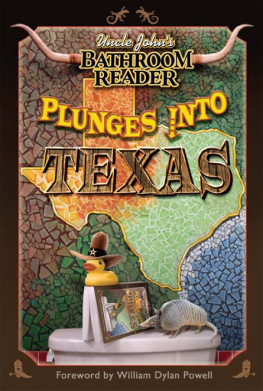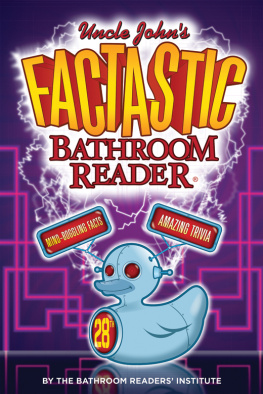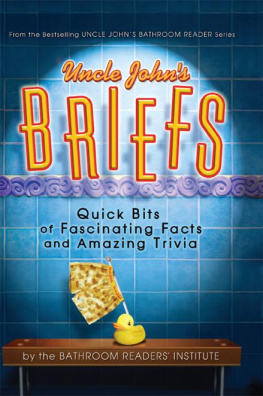Uncle Johns
BATHROOM
READER
PLUNGES
INTO
THE
UNIVERSE
The Bathroom Readers
Hysterical Society
San Diego, California
UNCLE JOHNS BATHROOM READER
PLUNGES INTO THE UNIVERSE
Copyright 2002 Portable Press
All rights reserved. No part of this publication may be reproduced, distributed, or transmitted in any form or by any means, including photocopying, recording, or other electronic or mechanical methods, without the prior written permission of the publisher, except in the case of brief quotations embodied in critical reviews and certain other noncommercial uses permitted by copyright law.
Portable Press/The Bathroom Readers Institute
An imprint of Printers Row Publishing Group
10350 Barnes Canyon Road, Suite 100
San Diego, CA 92121
www.bathroomreader.com
Email: mail@bathroomreader.com
All correspondence concerning the content of this book should be addressed to Portable Press/The Bathroom Readers Institute, Editorial Department, at the above address.
Printers Row Publishing Group is a division of Readerlink Distribution Services, LLC.
The Portable Press, Bathroom Readers Institute, and Uncle Johns Bathroom Reader names and logos are trademarks of Readerlink Distribution Services, LLC.
Cover design by Michael Brunsfeld, ()
eISBN 13: 9781607106821
e-book edition: July 2012
Project Team:
Gordon Javna, Publisher
JoAnn Padgett, Director, Editorial & Production
Stephanie Spadaccini, Project Editor
Allison Bocksruker, Project Manager
Georgine Lidell, Inventory Manager
THANK YOU!
The Bathroom Readers Hysterical Society sincerely thanks the people whose advice and assistance made this book possible.
Bernadette Baillie
Michael Brunsfeld
Melinda Allman
Michele Crim
Dylan Drake
Rachael Ettelman
Julia Papps
Brandie Jeffreys
Dan Mansfield
Heinrich Mentius
Mana Monzavi
Janet Nelson
Jay Newman
Ellen OBrien
Ken & Kelly Padgett
Sydney Stanley
William H. Stoddard
Jennifer Thornton
Charlie & Cindy Tillinghast
Hi Mom!
CONTENTS
*Extra-long articles suitable for an extended sitting session are marked with an asterisk.
W eve finally made it. Our new book, Uncle John Plunges Into the Universe, is a reality. Hmm. What is reality? What is the sound of one hand clapping? How much wood would a woodchuck chuck, if a woodchuck could chuck... but I digress.
Its time for us to write the introduction and then the last pageone of our favorites, because we look forward to telling you about some of the new and exciting things that were planning in the futuresort of like visualizing a garden as you plant the seeds. Then were finished.
JoAnn can go home and sleep for three days (as if!); Allison can remove her intravenous espresso drip; the rest of us can reflect on what a crazy and exciting experience its been to put this latest book togetherand wonder how the heck were going to top this one. Well certainly give it our very best effort.
And now for a sneak peek at a few of the mind-bending articles we have in store for you when you take the plunge between the covers of this bookand we guarantee that theyll keep you on the edge of your seat:
The Green Flash: Myth or reality? Get the inside info on the best methods for pursuing this elusive and legendary sunset phenomenon. Rememberdont blink...
What animal has a nose so sensitive that it can detect one odor particle per billion and whose detective abilities have been used not only to sniff out land mines but also diag(nose) disease? In Its Not Just Wet and Cold we investigate the amazing workings of this incredible schnozz.
We investigate a fascinating form of alternative cuisine popular all around the world in Waiter! Put More Flies in My Soup!
We go astrophysical in How to Make a Black Hole.
We present our theories behind the current explosion of home runs in the major leagues in Barry Bonds Kicks Ash.
And, finally learn how much wood a woodchuck could chuck in Ask Uncle John: Zen Questions.
And as for you, our cherished, loyal (and extremely well-informed) readers...
In this vast universe, though there are seemingly billions and billions of fascinating facts to ponder, occasionally we may present an article (or two) on a topic that may seem familiar to you. We try our hardest to avoid this, but sometimes Uncle John is a little forgetfuland honestly, some of these topics are so darned interesting that we think they can bear examination from another (and possibly new) angle.
That saidyour thoughts, opinions, and input on these matters are always appreciated, and if you have specific questions about the Plunges Into series, please contact us at .
So please bear with uswe think that this book is absolutely crammed with fascinating and unusual facts, a slightly more acerbic viewpoint, and lots of good old-fashioned reading that we hope youll enjoy reading it as much as we enjoyed putting it together for you.
Sit down and be counted.
As always, go with the flow...
Uncle John and the BRI Staff
Let your opinions be known! Join us at www.bathroomreader.com.
And were not stopping until we get there!
G o get a shovel. Why? Because were diggingyoull be doing most of the heavy workright straight down to the very core of the earth. Oh, dont look like that! Your mom told us you tried to dig to China all the time when you were a kid. And this time, were only going half as far.
The crust: Lets start at the top, which is, conveniently enough, where we are anyway. The earths crust is where we keep pretty much everythingthe oceans, the continents, our cities, ourselves. The crust appears substantial to us, but as far as layers of the earth go, its both the thinnest (40 miles thick on the continents and as little as 9 miles thick underneath the oceans) and the lightestmade of materials that floated to the top, as it were. What is in the crust depends on where you are. On the continents, the crust is mostly granitic rock, while the ocean floor is mostly basalt. (Why? Granite is lighter than basalt and floats above the heavier rock.)
Relative to Earths size (almost 8,000 miles in diameter), the crust is incredibly thinmuch thinner than an eggshell would be if it were shrunk down to the same size. The crust also has a definite boundary, something called the Mohorovicic discontinuity. The Moho (as its known to geologists who want to sound hip and cool to their grad students) marks the place where seismic waves traveling down through the crust of the earth suddenly speed up. Why? Because right on the other side of the Moho is:
A person takes an average of 16 breaths a minute.
The mantle: Like the crust, the mantle is made up of rocky material. However, there are two major differences. The rocky material in the mantle is denserthis is why the seismic waves speed upand its quite a bit hotter: some 1,800F (982C) at the top of the mantle and even toastier as you head down. (If we were really digging our way down to the core, we would have basted in our own juices by the time we reached the mantle, not to mention that our shovels would have melted.) The heat gives the rocky material in the mantle the consistency of Silly Putty. Unlike the crust, the mantle is impressively thick: some 1,800 miles deep. Whats waiting on the other side?
The outer core: The outer core is denser still than the mantle because its made of molten metal: mostly iron, some nickel, and some sulfur and oxygen tossed in as well, broiling along at a temperature of 6,700F (3,704C). All this liquid iron sloshing around in the outer core is whats thought to give the earth its impressive magnetic field: The convection currents in the liquid generate the field. This is good news for us, since our planets magnetic field deflects a substantial amount of harmful cosmic rays from the earths surface. The outer cores environs are hellish, but they help make our planet a paradise for life.
Next page








